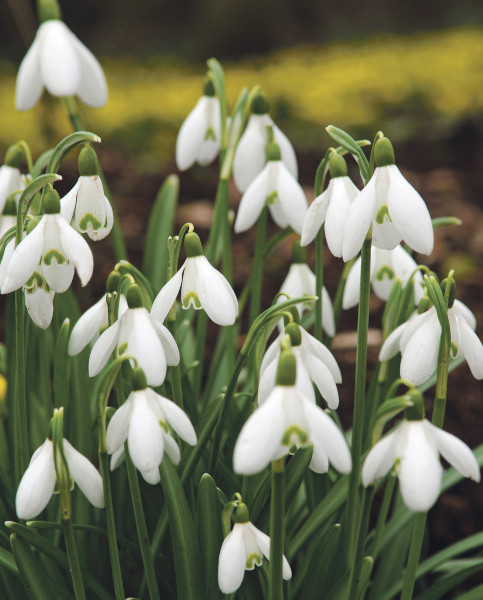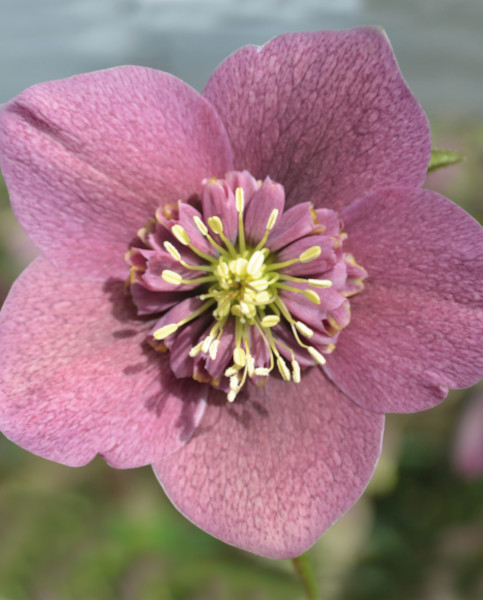How to grow Galanthus
Galanthus, most well-known to us as Snowdrops, are a welcome sight so early in the gardening calendar, often surprising us by flowering against the odds when snow is still on the ground.
The little nodding heads of pure white can be found in the single teardrop of Galanthus nivalis, or ruffled doubles with layer upon layer of green marked petals, such as Galanthus nivalis Flore Pleno.
Partial shade or woodland areas where Galanthus can naturalise are the best spots for planting these precious blooms, perhaps beneath a tree or to brighten a shaded corner of your patio or garden.
Galanthus are not often used as a cut flower because the stems and vase-life are so short, but a tiny little vase of these sweet and scented blooms in home is such a treat as we start to say goodbye to winter.

Key Information
Soil pH
Position
Hardiness


Where & when to plant Galanthus
Position- Partial shade
Soil- Moist and well-drained
Flowering Period- Winter
Hardiness- Hardy
Galanthus are best planted in areas where they can naturalise and spread – grassy areas, hedgerows, or dappled shade are perfect and where they will thrive naturally. The bulbs are extremely hardy and reliably perennial.
You should plant Galanthus bulbs in moist well-drained soil which is rich in humus. Incorporate some organic matter to the planting area, ideally leaf-mould, and if you garden on heavy clay, add a layer of grit for drainage too.
Dry bulbs should be planted in early autumn, or you can plant Snowdrops ‘in the green’ soon after flowering when they have some foliage still attached to the bulb.
How to plant Galanthus
Plant the bulbs with the pointy end facing upwards, 10cm deep and 10cm apart, into moist, well-drained, humus-rich soil, incorporating organic matter and if planting in heavy clay, add a layer of grit for drainage too.
Cover your bulbs with soil and water in well. You should water the ground regularly if the weather is particularly dry as Galanthus bulbs are prone to drying out quickly.
Galanthus can also be grown in a pot where their delicate beauty can be seen and enjoyed up close, ideally just for the first year. Use a good peat-free multipurpose compost which has been enriched with leaf mould and has a layer of grit for drainage in the base. Ensure your pot is well watered and never allow the soil to dry out.

What to plant with Galanthus
In our opinion, every garden has room for a little Galanthus! These pure white beauties are something to look forward to as we enter a new year, illuminating the cold and sometimes dismal days.
If you have the space to allow Galanthus to naturalise, then drifts or carpets of white look fabulous in a landscape of fresh green.
Plant Galanthus under deciduous trees or hedges where they will thrive in an environment of semi-shade and rich damp earth, lighting up otherwise bare spaces. The patterned leaves of Arums work well next to Galanthus in shaded areas and excel in the same conditions.
Crocus and Hellebores usually flower at a similar time to Snowdrops and the combination of early spring flowers brings welcome joy and colour. Try combining the fresh white pendants of Galanthus nivalis, our Lilac Skies Crocus Collection and Helleborus Single Red Fuchsia for a stylish and contemporary group planting.
Grow Galanthus next to bright yellow Eranthis hyemalis Winter Aconite along a woodland pathway or in a dark corner to add some colourful spring cheer.



How to care for Galanthus
Galanthus require almost no maintenance once established. Feeding and watering is not necessary.
After flowering, leave the foliage to die back naturally, allowing the bulbs to photosynthesise and reserve nutrients for next year. Deadhead to prevent energy being used to produce seed. If grown amongst grass, do not mow until the leaves have died back.
Divide clumps every few years after the foliage has faded by lifting and splitting into smaller sections for replanting.
More vigorous and healthier when planted in the ground, consider relocating pot grown Snowdrops to the garden after the first year.
How to propagate Galanthus
Propagate your Galanthus by lifting and dividing established clumps of bulbs every few years. This should be carried out in late spring, after the plants have flowered.
You can replant smaller sections of bulbs into a new area of your garden or share them with friends and family.
If you are replanting new divisions straight away in your garden, dig fresh planting holes and add leaf-mould and grit as before.
Using a garden fork, dig carefully around your Galanthus clumps taking care to not damage the bulbs. Lift the whole clump from the ground and gently separate it into smaller sections, each containing several bulbs with the foliage still attached.
Plant the divisions into their new spaces at the same depth they were previously growing and water well until established, especially if it is dry.
Galanthus can be grown from seed but will take many years to flower when propagated this way. New bulbs, or divided clumps are therefore the most commonly chosen method of adding more plants to your collection.




